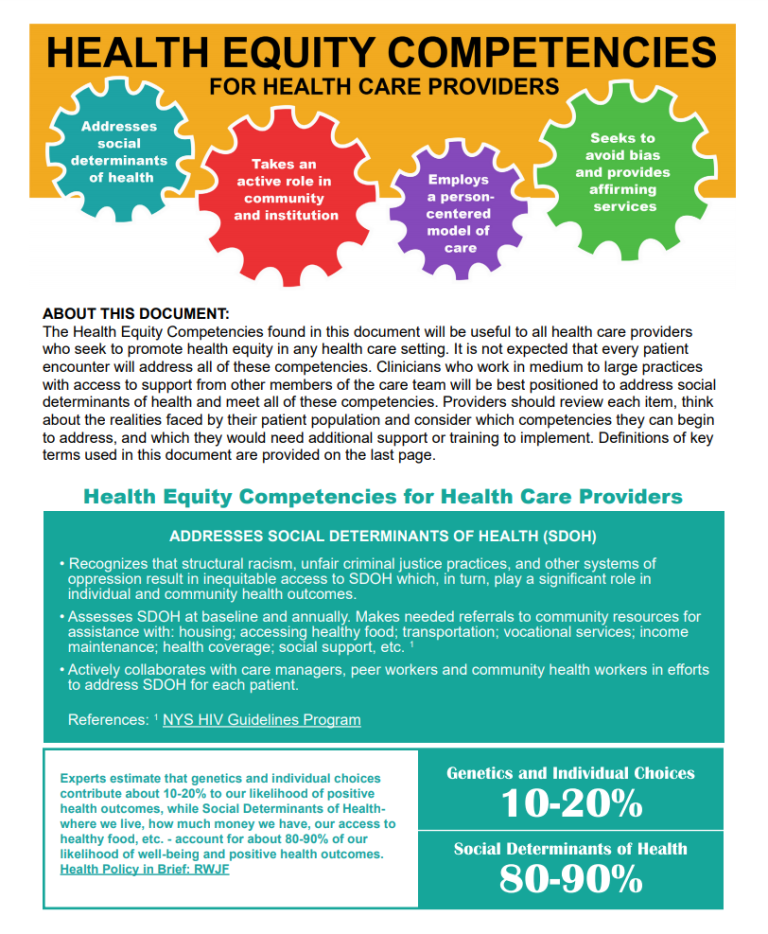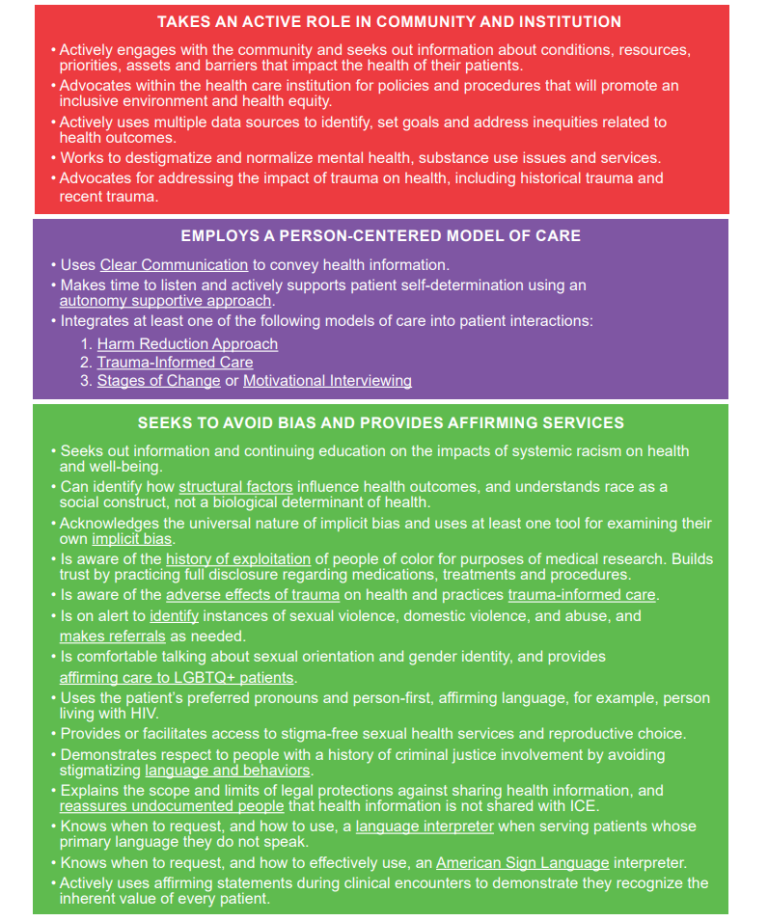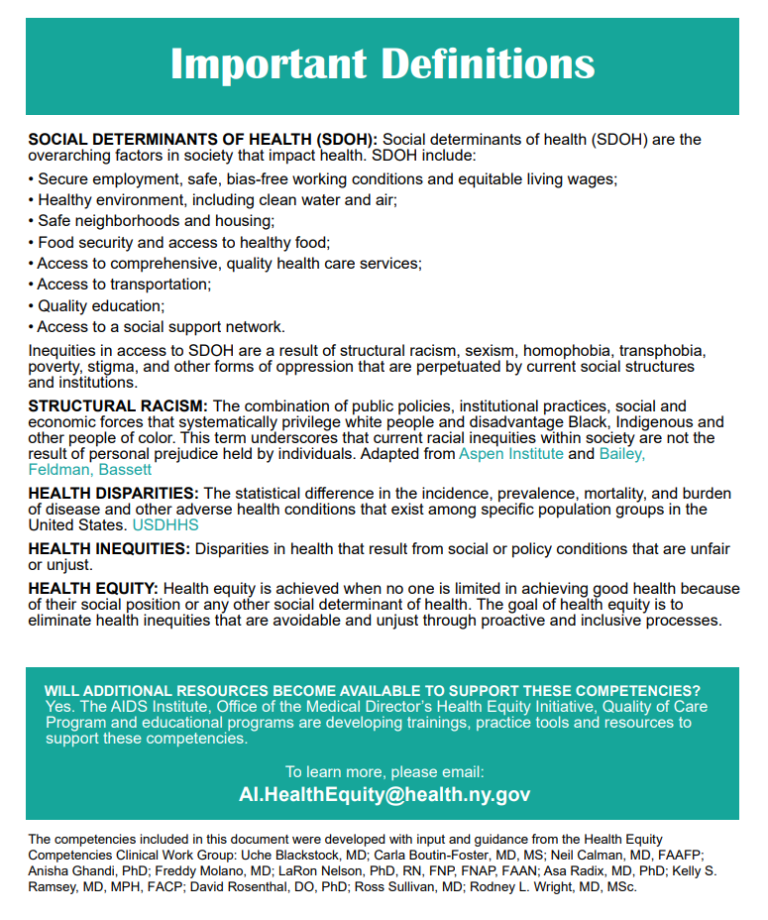Clinical Guidelines Program Approach to Shared Decision-Making
Download Printable PDF of Shared Decision-Making Statement
Date of current publication: August 8, 2023
Lead authors: Jessica Rodrigues, MS; Jessica M. Atrio, MD, MSc; and Johanna L. Gribble, MA
Writing group: Steven M. Fine, MD, PhD; Rona M. Vail, MD; Samuel T. Merrick, MD; Asa E. Radix, MD, MPH, PhD; Christopher J. Hoffmann, MD, MPH; Charles J. Gonzalez, MD
Committee: Medical Care Criteria Committee
Date of original publication: August 8, 2023
Rationale
Throughout its guidelines, the New York State Department of Health (NYSDOH) AIDS Institute (AI) Clinical Guidelines Program recommends “shared decision-making,” an individualized process central to patient-centered care. With shared decision-making, clinicians and patients engage in meaningful dialogue to arrive at an informed, collaborative decision about a patient’s health, care, and treatment planning. The approach to shared decision-making described here applies to recommendations included in all program guidelines. The included elements are drawn from a comprehensive review of multiple sources and similar attempts to define shared decision-making, including the Institute of Medicine’s original description [Institute of Medicine 2001]. For more information, a variety of informative resources and suggested readings are included at the end of the discussion.
Benefits
The benefits to patients that have been associated with a shared decision-making approach include:
- Decreased anxiety [Niburski, et al. 2020; Stalnikowicz and Brezis 2020]
- Increased trust in clinicians [Acree, et al. 2020; Groot, et al. 2020; Stalnikowicz and Brezis 2020]
- Improved engagement in preventive care [McNulty, et al. 2022; Scalia, et al. 2022; Bertakis and Azari 2011]
- Improved treatment adherence, clinical outcomes, and satisfaction with care [Crawford, et al. 2021; Bertakis and Azari 2011; Robinson, et al. 2008]
- Increased knowledge, confidence, empowerment, and self-efficacy [Chen, et al. 2021; Coronado-Vázquez, et al. 2020; Niburski, et al. 2020]
Approach
Collaborative care: Shared decision-making is an approach to healthcare delivery that respects a patient’s autonomy in responding to a clinician’s recommendations and facilitates dynamic, personalized, and collaborative care. Through this process, a clinician engages a patient in an open and respectful dialogue to elicit the patient’s knowledge, experience, healthcare goals, daily routine, lifestyle, support system, cultural and personal identity, and attitudes toward behavior, treatment, and risk. With this information and the clinician’s clinical expertise, the patient and clinician can collaborate to identify, evaluate, and choose from among available healthcare options [Coulter and Collins 2011]. This process emphasizes the importance of a patient’s values, preferences, needs, social context, and lived experience in evaluating the known benefits, risks, and limitations of a clinician’s recommendations for screening, prevention, treatment, and follow-up. As a result, shared decision-making also respects a patient’s autonomy, agency, and capacity in defining and managing their healthcare goals. Building a clinician-patient relationship rooted in shared decision-making can help clinicians engage in productive discussions with patients whose decisions may not align with optimal health outcomes. Fostering open and honest dialogue to understand a patient’s motivations while suspending judgment to reduce harm and explore alternatives is particularly vital when a patient chooses to engage in practices that may exacerbate or complicate health conditions [Halperin, et al. 2007].
Options: Implicit in the shared decision-making process is the recognition that the “right” healthcare decisions are those made by informed patients and clinicians working toward patient-centered and defined healthcare goals. When multiple options are available, shared decision-making encourages thoughtful discussion of the potential benefits and potential harms of all options, which may include doing nothing or waiting. This approach also acknowledges that efficacy may not be the most important factor in a patient’s preferences and choices [Sewell, et al. 2021].
Clinician awareness: The collaborative process of shared decision-making is enhanced by a clinician’s ability to demonstrate empathic interest in the patient, avoid stigmatizing language, employ cultural humility, recognize systemic barriers to equitable outcomes, and practice strategies of self-awareness and mitigation against implicit personal biases [Parish, et al. 2019].
Caveats: It is important for clinicians to recognize and be sensitive to the inherent power and influence they maintain throughout their interactions with patients. A clinician’s identity and community affiliations may influence their ability to navigate the shared decision-making process and develop a therapeutic alliance with the patient and may affect the treatment plan [KFF 2023; Greenwood, et al. 2020]. Furthermore, institutional policy and regional legislation, such as requirements for parental consent for gender-affirming care for transgender people or insurance coverage for sexual health care, may infringe upon a patient’s ability to access preventive- or treatment-related care [Sewell, et al. 2021].
Figure 1: Elements of Shared Decision-Making

Download figure: Elements of Shared Decision-Making
Health equity: Adapting a shared decision-making approach that supports diverse populations is necessary to achieve more equitable and inclusive health outcomes [Castaneda-Guarderas, et al. 2016]. For instance, clinicians may need to incorporate cultural- and community-specific considerations into discussions with women, gender-diverse individuals, and young people concerning their sexual behaviors, fertility intentions, and pregnancy or lactation status. Shared decision-making offers an opportunity to build trust among marginalized and disenfranchised communities by validating their symptoms, values, and lived experience. Furthermore, it can allow for improved consistency in patient screening and assessment of prevention options and treatment plans, which can reduce the influence of social constructs and implicit bias [Castaneda-Guarderas, et al. 2016].
Clinician bias has been associated with health disparities and can have profoundly negative effects [FitzGerald and Hurst 2017; Hall, et al. 2015]. It is often challenging for clinicians to recognize and set aside personal biases and to address biases with peers and colleagues. Consciously or unconsciously, negative or stigmatizing assumptions are often made about patient characteristics, such as race, ethnicity, gender, sexual orientation, mental health, and substance use [Avery, et al. 2019; van Boekel, et al. 2013; Livingston, et al. 2012]. With its emphasis on eliciting patient information, a shared decision-making approach encourages clinicians to inquire about patients’ lived experiences rather than making assumptions and to recognize the influence of that experience in healthcare decision-making.
Stigma: Stigma may prevent individuals from seeking or receiving treatment and harm reduction services [Tsai, et al. 2019]. Among people with HIV, stigma and medical mistrust remain significant barriers to healthcare utilization, HIV diagnosis, and medication adherence and can affect disease outcomes [Turan, et al. 2017; Chambers, et al. 2015], and stigma among clinicians against people who use substances has been well-documented [Stone, et al. 2021; Tsai, et al. 2019; van Boekel, et al. 2013]. Sexual and reproductive health, including strategies to prevent HIV transmission, acquisition, and progression, may be subject to stigma, bias, social influence, and violence.
| SHARED DECISION-MAKING IN HIV CARE |
|
Resources and Suggested Reading
In addition to the references cited below, the following resources and suggested reading may be useful to clinicians.
| RESOURCES |
References
Acree ME, McNulty M, Blocker O, et al. Shared decision-making around anal cancer screening among black bisexual and gay men in the USA. Cult Health Sex 2020;22(2):201-16. [PMID: 30931831]
Avery JD, Taylor KE, Kast KA, et al. Attitudes toward individuals with mental illness and substance use disorders among resident physicians. Prim Care Companion CNS Disord 2019;21(1):18m02382. [PMID: 30620451]
Bertakis KD, Azari R. Patient-centered care is associated with decreased health care utilization. J Am Board Fam Med 2011;24(3):229-39. [PMID: 21551394]
Castaneda-Guarderas A, Glassberg J, Grudzen CR, et al. Shared decision making with vulnerable populations in the emergency department. Acad Emerg Med 2016;23(12):1410-16. [PMID: 27860022]
Chambers LA, Rueda S, Baker DN, et al. Stigma, HIV and health: a qualitative synthesis. BMC Public Health 2015;15:848. [PMID: 26334626]
Chen CH, Kang YN, Chiu PY, et al. Effectiveness of shared decision-making intervention in patients with lumbar degenerative diseases: a randomized controlled trial. Patient Educ Couns 2021;104(10):2498-2504. [PMID: 33741234]
Coronado-Vázquez V, Canet-Fajas C, Delgado-Marroquín MT, et al. Interventions to facilitate shared decision-making using decision aids with patients in primary health care: a systematic review. Medicine (Baltimore) 2020;99(32):e21389. [PMID: 32769870]
Coulter A, Collins A. Making shared decision-making a reality: no decision about me, without me. 2011. https://www.kingsfund.org.uk/sites/default/files/Making-shared-decision-making-a-reality-paper-Angela-Coulter-Alf-Collins-July-2011_0.pdf
Crawford J, Petrie K, Harvey SB. Shared decision-making and the implementation of treatment recommendations for depression. Patient Educ Couns 2021;104(8):2119-21. [PMID: 33563500]
FitzGerald C, Hurst S. Implicit bias in healthcare professionals: a systematic review. BMC Med Ethics 2017;18(1):19. [PMID: 28249596]
Greenwood BN, Hardeman RR, Huang L, et al. Physician-patient racial concordance and disparities in birthing mortality for newborns. Proc Natl Acad Sci U S A 2020;117(35):21194-21200. [PMID: 32817561]
Groot G, Waldron T, Barreno L, et al. Trust and world view in shared decision making with indigenous patients: a realist synthesis. J Eval Clin Pract 2020;26(2):503-14. [PMID: 31750600]
Hall WJ, Chapman MV, Lee KM, et al. Implicit racial/ethnic bias among health care professionals and its influence on health care outcomes: a systematic review. Am J Public Health 2015;105(12):e60-76. [PMID: 26469668]
Halperin B, Melnychuk R, Downie J, et al. When is it permissible to dismiss a family who refuses vaccines? Legal, ethical and public health perspectives. Paediatr Child Health 2007;12(10):843-45. [PMID: 19043497]
Institute of Medicine. Crossing the quality chasm: a new health system for the 21st century. 2001. https://www.ncbi.nlm.nih.gov/books/NBK222274/
KFF. Key data on health and health care by race and ethnicity. 2023 Mar 15. https://www.kff.org/racial-equity-and-health-policy/report/key-data-on-health-and-health-care-by-race-and-ethnicity/ [accessed 2023 May 19]
Livingston JD, Milne T, Fang ML, et al. The effectiveness of interventions for reducing stigma related to substance use disorders: a systematic review. Addiction 2012;107(1):39-50. [PMID: 21815959]
McNulty MC, Acree ME, Kerman J, et al. Shared decision making for HIV pre-exposure prophylaxis (PrEP) with black transgender women. Cult Health Sex 2022;24(8):1033-46. [PMID: 33983866]
Niburski K, Guadagno E, Abbasgholizadeh-Rahimi S, et al. Shared decision making in surgery: a meta-analysis of existing literature. Patient 2020;13(6):667-81. [PMID: 32880820]
Parish SJ, Hahn SR, Goldstein SW, et al. The International Society for the Study of Women’s Sexual Health process of care for the identification of sexual concerns and problems in women. Mayo Clin Proc 2019;94(5):842-56. [PMID: 30954288]
Robinson JH, Callister LC, Berry JA, et al. Patient-centered care and adherence: definitions and applications to improve outcomes. J Am Acad Nurse Pract 2008;20(12):600-607. [PMID: 19120591]
Scalia P, Durand MA, Elwyn G. Shared decision-making interventions: an overview and a meta-analysis of their impact on vaccine uptake. J Intern Med 2022;291(4):408-25. [PMID: 34700363]
Sewell WC, Solleveld P, Seidman D, et al. Patient-led decision-making for HIV preexposure prophylaxis. Curr HIV/AIDS Rep 2021;18(1):48-56. [PMID: 33417201]
Stalnikowicz R, Brezis M. Meaningful shared decision-making: complex process demanding cognitive and emotional skills. J Eval Clin Pract 2020;26(2):431-38. [PMID: 31989727]
Stone EM, Kennedy-Hendricks A, Barry CL, et al. The role of stigma in U.S. primary care physicians’ treatment of opioid use disorder. Drug Alcohol Depend 2021;221:108627. [PMID: 33621805]
Tsai AC, Kiang MV, Barnett ML, et al. Stigma as a fundamental hindrance to the United States opioid overdose crisis response. PLoS Med 2019;16(11):e1002969. [PMID: 31770387]
Turan B, Budhwani H, Fazeli PL, et al. How does stigma affect people living with HIV? The mediating roles of internalized and anticipated HIV stigma in the effects of perceived community stigma on health and psychosocial outcomes. AIDS Behav 2017;21(1):283-91. [PMID: 27272742]
van Boekel LC, Brouwers EP, van Weeghel J, et al. Stigma among health professionals towards patients with substance use disorders and its consequences for healthcare delivery: systematic review. Drug Alcohol Depend 2013;131(1-2):23-35. [PMID: 23490450]
NYSDOH HIV Care Provider Definitions
Throughout HIV-related guidelines and other materials, when reference is made to “experienced HIV care provider” or “expert HIV care provider,” those terms are referring to the following 2017 NYSDOH AI definitions:
- Experienced HIV care provider: Practitioners who have been accorded HIV Experienced Provider status by the American Academy of HIV Medicine or have met the HIV Medicine Association’s definition of an experienced provider are eligible for designation as an HIV Experienced Provider in New York State. Nurse practitioners and licensed midwives who provide clinical care to individuals with HIV in collaboration with a physician may be considered HIV Experienced Providers as long as all other practice agreements are met (8 NYCRR 79-5:1; 10 NYCRR 85.36; 8 NYCRR 139-6900). Physician assistants who provide clinical care to individuals with HIV under the supervision of an HIV Specialist physician may also be considered HIV Experienced Providers (10 NYCRR 94.2)
- Expert HIV care provider: A provider with extensive experience in the management of complex patients with HIV.
Use of Dolutegravir in Individuals of Childbearing Capacity
Lead author: Geoffrey A. Weinberg, MD, with the Medical Care Criteria Committee; May 2021
Potentially increased NTDs and DTG: NTDs are birth defects, including meningomyelocele and spina bifida, thought to occur early after conception during development of the embryonic neural tube. The neural tube closes by approximately 8 weeks gestational age, which is 8 weeks after the last menstrual period or approximately 6 weeks post-conception. Ingestion of folic acid or folate by a pregnant individual significantly lowers the rate of NTDs; all individuals in the United States who are pregnant or trying to conceive and engaged in prenatal care are routinely administered 400 µg of folic acid daily. The background rate of NTDs in the general population in the United States and other countries that routinely fortify food with folate or folic acid is low: approximately 0.07% of all births (7/10,000 births) [Reefhuis, et al. 2020].
In 2018, an unplanned interim analysis of a large observational clinical trial conducted in Botswana, a country where food is not routinely fortified with folate or folic acid, was performed. The researchers found NTDs in 0.94% of 426 infants exposed at conception to maternal DTG-based antiretroviral therapy (ART) compared with 0.12% of 11,300 infants exposed to non–DTG-based ART. Importantly, however, as more data were collected, the rates of infant NTDs markedly declined [Antiretroviral Pregnancy Registry Steering Committee 2022; DHHS 2022; Zash 2020; Zash, et al. 2019; Zash, et al. 2018]. The latest available data, through April 2020, now show that the rate of infant NTDs with maternal DTG-based ART use at conception is not any greater than it is in infants exposed to non–DTG-based ART at conception: 0.19% [Antiretroviral Pregnancy Registry Steering Committee 2022; DHHS 2022; Zash 2020]. No increases have been found in the registry data or through pharmacovigilance database studies from Europe and the United States [van De Ven, et al. 2020; Vannappagari and Thorne 2019]. Nor have any differences been found in the rates of NTDs among infants in a randomized controlled open-label phase 3 trial of DTG-based versus EFV-based ART in pregnant individuals, though the median gestational age at enrollment in this trial was 22 weeks, and all enrollees were at 14 weeks or more gestational age at enrollment [Lockman, et al. 2021].
Benefits of DTG: There are many known benefits of DTG as a component of ART for all adults, pregnant or not, and many children. DTG is potent, rapidly reduces viral load, has a high barrier to HIV genetic resistance, and is generally well-tolerated. Moreover, folate deficiency is uncommon in countries such as the United States. Thus, both the U.S. Department of Health and Human Services and the World Health Organization consider DTG a preferred ARV drug for individuals with HIV in all trimesters of pregnancy, and those with HIV who are trying to conceive. If an alternative ART regimen that does not include DTG is the best choice, alternatives to DTG during pregnancy include raltegravir, ritonavir-boosted atazanavir, or ritonavir-boosted darunavir (see the NYSDOH AI guideline Selecting an Initial ART Regimen > Specific Factors to Consider and Discuss With Patients). No data currently exist to support the use of bictegravir during pregnancy or the period surrounding conception. Further, cobicistat-boosted regimens containing elvitegravir, darunavir, or atazanavir are not recommended due to reduced levels of the integrase inhibitors given with cobicistat during pregnancy.
References
Antiretroviral Pregnancy Registry Steering Committee. Antiretroviral Pregnancy Registry Interim Report for 1 January 1989 – 31 July 2022. 2022 Dec 19. http://apregistry.com/forms/exec-summary.pdf [accessed 2021 Apr 19]
DHHS. Recommendations for the Use of Antiretroviral Drugs During Pregnancy and Interventions to Reduce Perinatal HIV Transmission in the United States. 2022 Mar 17. https://clinicalinfo.hiv.gov/en/guidelines/perinatal/whats-new-guidelines [accessed 2021 Apr 19]
Lockman S, Brummel SS, Ziemba L, et al. Efficacy and safety of dolutegravir with emtricitabine and tenofovir alafenamide fumarate or tenofovir disoproxil fumarate, and efavirenz, emtricitabine, and tenofovir disoproxil fumarate HIV antiretroviral therapy regimens started in pregnancy (IMPAACT 2010/VESTED): a multicentre, open-label, randomised, controlled, phase 3 trial. Lancet 2021;397(10281):1276-1292. [PMID: 33812487]
Reefhuis J, FitzHarris LF, Gray KM, et al. Neural tube defects in pregnancies among women with diagnosed HIV infection – 15 jurisdictions, 2013-2017. MMWR Morb Mortal Wkly Rep 2020;69(1):1-5. [PMID: 31917782]
van De Ven NS, Pozniak AL, Levi JA, et al. Analysis of pharmacovigilance databases for dolutegravir safety in pregnancy. Clin Infect Dis 2020;70(12):2599-2606. [PMID: 31595301]
Vannappagari V, Thorne C. Pregnancy and neonatal outcomes following prenatal exposure to dolutegravir. J Acquir Immune Defic Syndr 2019;81(4):371-378. [PMID: 30939532]
Zash R. Update on neural tube defects with antiretroviral exposure in the Tsepamo study, Botswana. IAC; 2020 Jul 6-10; Virtual. https://www.natap.org/2020/IAC/IAC_112.htm
Zash R, Holmes L, Diseko M, et al. Neural-tube defects and antiretroviral treatment regimens in Botswana. N Engl J Med 2019;381(9):827-840. [PMID: 31329379]
Zash R, Makhema J, Shapiro RL. Neural-tube defects with dolutegravir treatment from the time of conception. N Engl J Med 2018;379(10):979-981. [PMID: 30037297]
NYSDOH Health Equity Competencies for Health Care Providers
August 2021
Download Printable PDF of Health Equity Competencies
Health Equity Competencies Page 1

Health Equity Competencies Page 2

Health Equity Competencies Page 3

Selected Links: Resources for Clinicians
June 2022
New York State Department of Health:
- AIDS Drug Assistance Program (ADAP) Formulary
- Beyond Status
- Clinical Education Initiative (CEI): HIV Primary Care and Prevention, Sexual Health, HCV Treatment, and Drug User Health
- CEI: HIV Testing and Rapid ART Clinical Cards
- Communicable Disease Reporting
- Ending the AIDS Epidemic in New York State
- HIV/AIDS Laws & Regulations
- Medicaid Managed Care and Pharmacy Benefit Information Center
- AIDS Institute HIV Education and Training Programs
- HIV Care Provider Directory
- Provider Reporting & Partner Services
- Rapid Initiation of (HIV) Antiretroviral Treatment (RIA)
- Sexually Transmitted Infections (STIs) Information for Providers
- STI Self-Collection Outside of a Clinic Setting in New York State (NYS) Question & Answer
- Uninsured Care Programs
- What Health Care Providers Need to Know about Partner Services
New York City Health:
- Contact Notification Assistance Program (CNAP)
- HIV Undetectable = Untransmittable (U = U)
- How to Report a Diagnosis of HIV or AIDS
- Immediate Initiation of HIV Treatment
- Long-Acting HIV Treatment Is Now Available
Centers for Disease Control and Prevention:
Clinicalinfo.HIV.gov:
- Drug Database
- Guidelines for the Use of Antiretroviral Agents in Adults and Adolescents Living With HIV
- Guidelines for the Use of Antiretroviral Agents in Pediatric HIV Infection
HIV-ASSIST: Free Clinical Decision-Making Support for ARV Selection
Salzburg Global Seminar: Salzburg Statement on Shared Decision Making
University of California San Francisco National Clinician Consultation Center: HIV/AIDS Management
University of Liverpool: HIV Drug Interactions
Selected Links: Resources for Consumers
June 2023
New York State Department of Health:
- HIV/AIDS Basics
- Sexually Transmitted Infections
- Partner Services
- Uninsured Care Programs
- AIDS Institute Provider Directory (HIV, HCV, PEP, PrEP, Buprenorphine, STI Services, Opioid Overdose Prevention Program)
- Beyond Status
- Ending the Epidemic
- YGetIt? Project
New York City Health:
Centers for Disease Control and Prevention (CDC): HIV Basics
HIVinfo.NIH.gov: Understanding HIV
NAM Aidsmap: HIV Basics
The Body: The HIV/AIDS Resource
All FDA-Approved HIV Medications, With Brand Names and Abbreviations
Reviewed April 2024
Listed below are all FDA-approved HIV medications as of March 23, 2023, per HIVinfo.NIH.gov, with links to the Clinical Info HIV.gov drug database. The list is organized by drug class, with individual drugs listed in alphabetical order. Combination drugs are also listed in alphabetical order.
Nucleoside Reverse Transcriptase Inhibitors (NRTIs): characteristics
- Abacavir (ABC; Ziagen): FDA label | Patient info
- Emtricitabine (FTC; Emtriva): FDA label | Patient info
- Lamivudine (3TC; Epivir): FDA label | Patient info
- Tenofovir Disoproxil Fumarate (TDF; Viread): FDA label | Patient info
- Zidovudine (AZT, ZDV; Retrovir): FDA label | Patient info
Non-Nucleoside Reverse Transcriptase Inhibitors (NNRTIs): characteristics
- Doravirine (DOR; Pifeltro): FDA label | Patient info
- Efavirenz (EFV; Sustiva): FDA label | Patient info
- Etravirine (ETR; Intelence): FDA label | Patient info
- Nevirapine (NVP; Viramune, Viramune XR [extended release]): FDA label | Patient info
- Rilpivirine (RPV; Edurant): FDA label | Patient info
Protease Inhibitors (PIs): characteristics
- Atazanavir (ATV; Reyataz): FDA label | Patient info
- Darunavir (DRV; Prezista): FDA label | Patient info
- Fosamprenavir (FPV; Lexiva): FDA label | Patient info
- Ritonavir (RTV; Norvir): FDA label | Patient info
- Tipranavir (TPV; Aptivus): FDA label | Patient info
Fusion Inhibitor: characteristics
- Enfuvirtide (T-20; Fuzeon): FDA label | Patient info
CCR5 Antagonist: characteristics
- Maraviroc (MVC; Selzentry): FDA label | Patient info
Integrase Strand Transfer Inhibitors (INSTIs): characteristics
- Cabotegravir (CAB; Vocabria): FDA label | Patient info
- Dolutegravir (DTG; Tivicay): FDA label | Patient info
- Raltegravir (RAL; Isentress, Isentress HD): FDA label | Patient info
Attachment Inhibitor: characteristics
- Fostemsavir (FTR; Rukobia): FDA label | Patient info
Post-Attachment Inhibitor: characteristics
- Ibalizumab-uiyk (IBA; Trogarzo): FDA label | Patient info
Capsid Inhibitor: characteristics
- Lenacapavir (LEN; Sunlenca): FDA label | Patient info
Pharmacokinetic Enhancer: characteristics
- Cobicistat (COBI; Tybost): FDA label | Patient info
Combination HIV Medications:
- Abacavir/Lamivudine (ABC/3TC; Epzicom): FDA label | Patient info
- Abacavir/Dolutegravir/Lamivudine (ABC/DTG/3TC; Triumeq, Triumeq PD): FDA label | Patient info
- Abacavir/Lamivudine/Zidovudine (ABC/3TC/ZDV; Trizivir): FDA label | Patient info
- Atazanavir/Cobicistat (ATV/COBI; Evotaz): FDA label | Patient info
- Bictegravir/Emtricitabine/Tenofovir Alafenamide Fumarate (BIC/FTC/TAF; Biktarvy): FDA label | Patient info
- Cabotegravir/Rilpivirine (CAB/RPV; Cabenuva): FDA label | Patient info
- Darunavir/Cobicistat (DRV/COBI; Prezcobix): FDA label | Patient info
- Darunavir/Cobicistat/Emtricitabine/Tenofovir Alefenamide (DRV/COBI/FTC/TAF; Symtuza): FDA label | Patient info
- Dolutegravir/Lamivudine (DTG/3TC; Dovato): FDA label | Patient info
- Dolutegravir/Rilpivirine (DTG/RPV; Juluca): FDA label | Patient info
- Doravirine/Lamivudine/Tenofovir Disoproxil Fumarate (DOR/3TC/TDF; Delstrigo): FDA label | Patient info
- Efavirenz/Emtricitabine/Tenofovir Disoproxil Fumarate (EFV/FTC/TDF; Atripla): FDA label | Patient info
- Efavirenz/Lamivudine/Tenofovir Disoproxil Fumarate (EFV/3TC/TDF; Symfi, Symfi Lo): FDA label | Patient info
- Elvitegravir/Cobicistat/Emtricitabine/Tenofovir Alafenamide Fumarate (EVG/COBI/FTC/TAF; Genvoya): FDA label | Patient info
- Elvitegravir/Cobicistat/Emtricitabine/Tenofovir Disoproxil Fumarate (EVG/COBI/FTC/TDF; Stribild): FDA label | Patient info
- Emtricitabine/Rilpivirine/Tenofovir Alafenamide Fumarate (FTC/RPV/TAF; Odefsy): FDA label | Patient info
- Emtricitabine/Rilpivirine/Tenofovir Disoproxil Fumarate (FTC/RPV/TDF; Complera): FDA label | Patient info
- Emtricitabine/Tenofovir Alafenamide Fumarate (FTC/TAF; Descovy): FDA label | Patient info
- Emtricitabine/Tenofovir Disoproxil Fumarate (FTC/TDF; Truvada): FDA label | Patient info
- Lamivudine/Tenofovir Disoproxil Fumarate (3TC/TDF; Cimduo): FDA label | Patient info
- Lamivudine/Zidovudine (3TC/ZDV; Combivir): FDA label | Patient info
- Lopinavir/Ritonavir (LPV/r; Kaletra): FDA label | Patient info
Last updated on November 29, 2023

